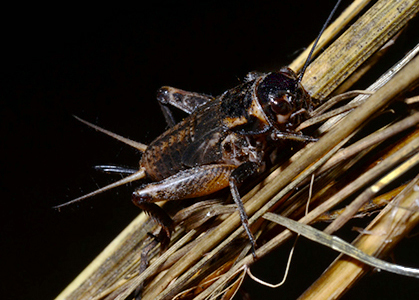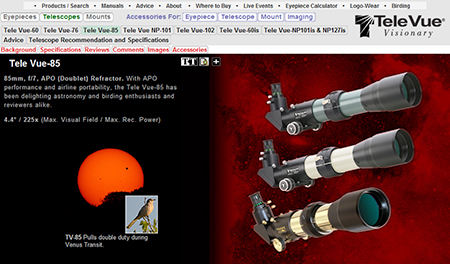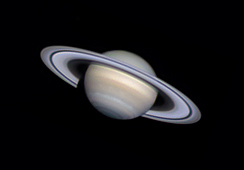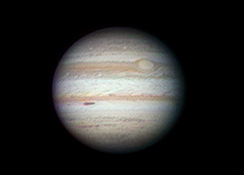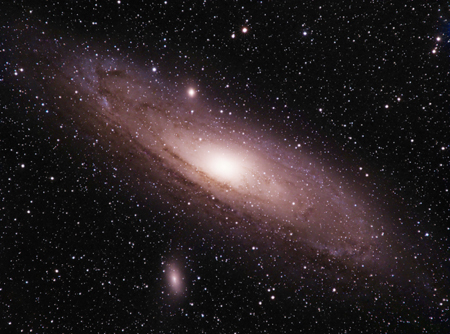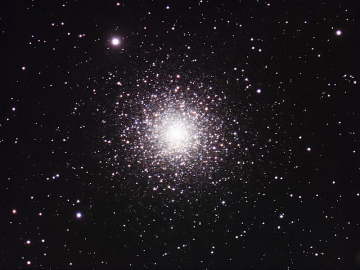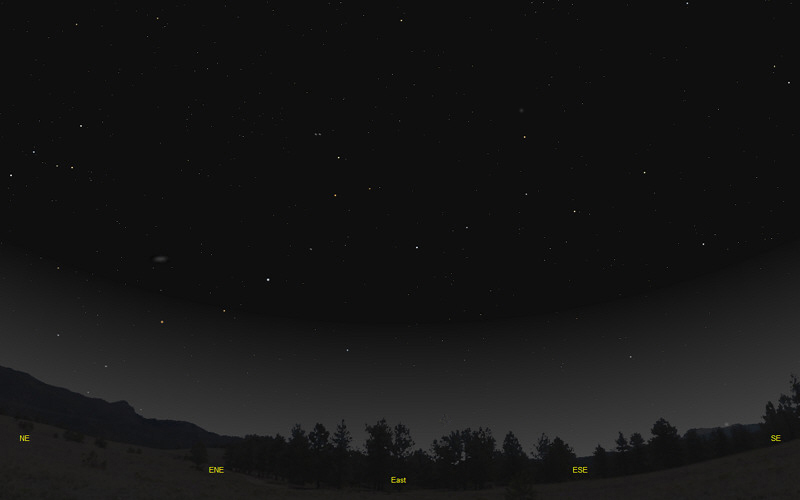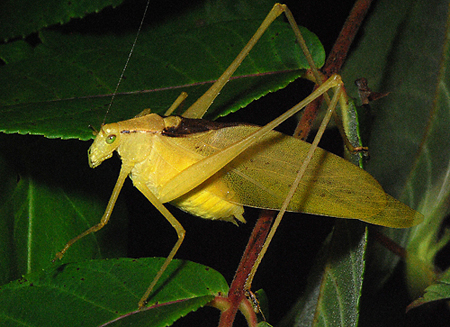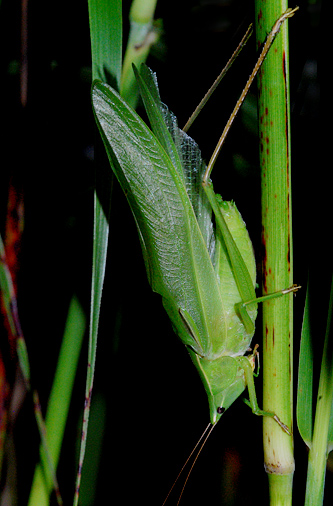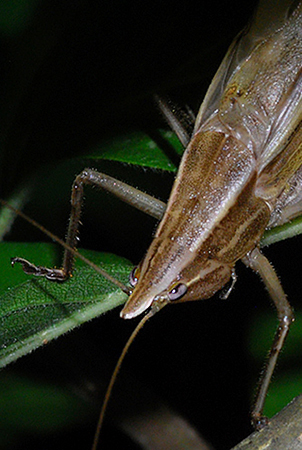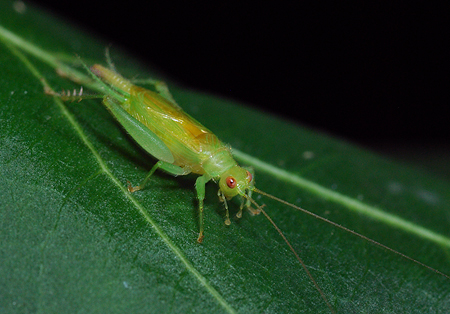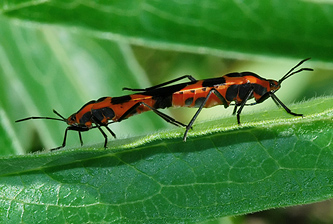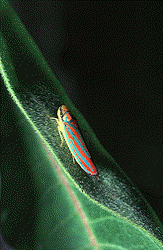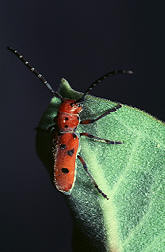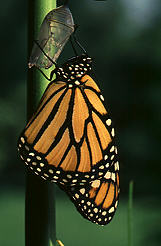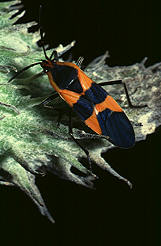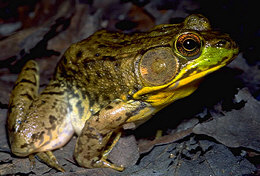The purpose of this feature is to give scout leaders, educators and naturalists an idea of some of the natural events coming up each month. We will try to cover a variety of natural events ranging from sky events to calling periods of amphibians, bird and mammal watching tips, prominent wildflowers and anything else that comes to mind. We will also note prominent constellations appearing over the eastern horizon at mid-evening each month for our area for those who would like to learn the constellations. If you have suggestions for other types of natural information you would like to see added to this calendar, let us know! Note: You can click on the hyperlinks to learn more about some of the featured items. To return to the Calendar, hit the "back" button on your browser, NOT the "back" button on the web page. All charts are available in a "printer friendly" mode, with black stars on a white background. Left clicking on each chart will take you to a printable black and white image. Please note that images on these pages are meant to be displayed at 100%. If your browser zooms into a higher magnification than that, the images may lose quality. Though we link book references to nationwide sources, we encourage you to support your local book store whenever possible. Notes and Images From July 2012
I found this little Eastern Striped Cricket on July 16th, as I was weeding the area around our telescope pier. The scientific name is Miogryllus saussurei. We recorded this species in May, and it took a while to identify its rather faint and unusual call. The call is short and raspy, distinctive but hard to describe. To hear one that we recorded on May 4th, click here - again, it's faint, and you'll need earphones to hear it well. This field cricket has some pale variable markings on its face, and a dark stripe down the center of its back.
We were pleased when Televue, the company that made our little 85mm refractor, chose to use some of our Venus transit images on their web site. This small refractor is a wonderful go-anywhere scope for both astronomy and birding. Clicking on the image at left will take you to the Televue site. If you then click on the Sun you'll be able to see the full size transit images.
Sky Events for August 2012: Landing of the Mars Rover Curiosity: You can watch the landing live on NASA TV. If you've never watched a NASA mission landing live, you're in for a treat. Coverage starts at 10:30pm August 5th, and you can find the link to NASA TV here. Can you stand the "seven minutes of terror?"
Note 08/07/12: Curiosity successfully landed at Gale crater! The vicinity of Gale crater is shown by the red arrow on this image that we took on February 7th of this year. The image was taken with our 20 inch Newtonian reflector and a Flea 3 video camera. The bright north polar cap is at the bottom in this image. Below and to the left of center are bright clouds over the Martian volcano Elysium Mons. A bluish cloud hangs over the the dark form of Syrtis Major, seen near the eastern limb of the planet.
Evening Sky:
Saturn, Mars and the bright star Spica form an interesting group at dusk in August. Look for Saturn about 22 degrees above the southwestern horizon as the sky darkens. Spica will be about 5 degrees below and to the left, while Mars will be about 8 degrees below and to the right. As the month progresses, Mars will appear to pass between Saturn and Spica. Morning Sky: The Perseid meteor shower peaks on the morning of August 12th. You may want to check the sky in the early morning hours a day or so before and after the shower.
Jupiter rises in Taurus about 1:33am CDT at the beginning of August. Venus rises about 2:41am CDT at the beginning of the month, also in Taurus. Mercury has a fine apparition this month, reaching its maximum elongation from the Sun on the morning of August 16th. Begin looking for the planet about 30 to 40 minutes before sunrise. On the 15th, Mercury will be about 8 degrees below and to the left of a pretty waning crescent Moon. Along with Venus and Jupiter, it should be a really nice view. Binoculars will help spot the planet, though it will not be hard to see with the naked eye. All times noted in the Sky Events are for Franklin, Tennessee and are Central Daylight Time. These times should be pretty close anywhere in the mid-state area. Constellations: The views below show the sky looking east at 10:00pm CDT on August 15th. The first view shows the sky with the constellations outlined and names depicted. Star and planet names are in green. Constellation names are in blue. The second view shows the same scene without labels. New constellations this month are Pegasus, the Flying Horse, Andromeda, Princess Andromeda, Triangulum, the Triangle, Pisces, the Fishes, and Aquarius, the Water Bearer.
Find the "Square of Pegasus" and work your way outward from it to the constellations around it. See if you can pick out the faint glow of the Andromeda Galaxy, over 2 million light years away! When you look at this galaxy you're seeing light that began its journey to us in the Pleistocene epoch. To get the best view, wait until the galaxy climbs high in the sky. The Andromeda Galaxy was first shown on star charts prepared in 905AD by the Persian astronomer, Al Sufi, and was referred to as the "Little Cloud." That describes well its appearance to the naked eye. Binoculars will greatly improve your view, as will driving out of the city and finding darker skies. Simon Marius, in 1610, was among the first to observe the Andromeda Galaxy through a small telescope. He compared its soft glow to "the light of a candle shining through horn." In dark skies, those using small telescopes may pick out the small satellite galaxies M32 (above and left of the nucleus of M31 in the above image) and NGC 205 (below). A faint tidal bridge connects NGC 205 to Messier 31. Our Milky Way Galaxy and the Andromeda Galaxy are approaching each other and are expected to collide in approximately 4.5 billion years. The two galaxies may merge into a single giant elliptical galaxy at that time.
In Pegasus, the reddish star Enif marks the nose of the flying horse. Just above Enif is the globular cluster Messier 15, a nice ball of stars about 33,600 light-years away. The cluster was discovered by Jean Dominique Maraldi on September 7th, 1746. Maraldi was searching for De Chéseaux' Comet at the time. This globular cluster is one of the densest known in our Milky Way galaxy. It contains nine known pulsars. As with Messier 31, you should wait until it has climbed high above the horizon to get the best telescopic view. It is easily visible in binoculars, and is said to be visible to the naked eye under really dark skies. In a small telescope it will appear like a little cotton ball of faint light. With increasing aperture, you'll be able to spot some of the faint stars around the periphery of the cluster. Be sure to use averted vision, looking to one side of the cluster, to allow the cluster's light to fall on the light-sensitive rod cells of your eye.
On Learning the Constellations: We advise learning a few constellations each month, and then following them through the seasons. Once you associate a particular constellation coming over the eastern horizon at a certain time of year, you may start thinking about it like an old friend, looking forward to its arrival each season. The stars in the evening scene above, for instance, will always be in the same place relative to the horizon at the same time and date each August. Of course, the planets do move slowly through the constellations, but with practice you will learn to identify them from their appearance. In particular, learn the brightest stars for they will guide you to the fainter stars. Once you can locate the more prominent constellations, you can "branch out" to other constellations around them. It may take you a little while to get a sense of scale, to translate what you see on the computer screen or what you see on the page of a book to what you see in the sky. Look for patterns, like the stars that make up the "Square of Pegasus." The earth's rotation causes the constellations to appear to
move across the sky just as the sun and the moon appear to do. If you go
outside earlier than the time shown on the charts, the constellations will be
lower to the eastern horizon. If you observe later, they will have climbed
higher. As each season progresses, the earth's motion around the sun
causes the constellations to appear a little farther towards the west each night
for any given time of night. If you want to see where the constellations
in the above figures will be on September 15th at 10:00pm CDT, you can stay up
till midnight on August 15th and get a preview. The westward
motion of the constellations is equivalent to two hours per month. Recommended: Sky & Telescope's Pocket Star Atlas is beautiful, compact star atlas. It is destined to become a classic, and is a joy to use at the telescope. A good book to learn the constellations is Patterns in the Sky, by Hewitt-White. You may also want to check out at H. A. Rey's classic, The Stars, A New Way to See Them. For skywatching tips, an inexpensive good guide is Secrets of Stargazing, by Becky Ramotowski. A good general reference book on astronomy is the Peterson
Field Guide,
A Field Guide to the Stars and Planets, by Pasachoff. The book retails for around $14.00. Starry Night has several software programs for learning the night sky. Visit the Starry Night web site at www.starrynight.com for details.
Insects:
For many people, one of the defining sounds of a summer night is the rhythmic chanting of katydids. For me the sound evokes memories of summer vacations when I was a kid. Our family often drove at night along state highways. The interstate system was still yet to come. Our car, like most cars then, did not have air conditioning, so the windows were down. As the highway wound through patches of forest the katydid calls grew louder, enveloped the car, then faded away. My brother and I stretched out on beds our parents made for us on the back seat and floor (no seatbelts then.) We drifted off to sleep to the comforting murmur of our parents' voices and the calls of the katydids, a lullaby.
The eyes of katydids are stunning, with the upper part yellow and the bottom a rich green. Only the males have the purple "cap." Katydids belong to the family Tettigoniidae. The call that is probably best known is that of the Northern True Katydid. It's in the subfamily Pseudophyllinae, and the species name is Pterophylla camellifolia. It ranges over most of the eastern United States. Northern True Katydids typically call from fairly high in the tree canopy, making them difficult to spot. The genus name, Pterophylla, literally means "wing leaf" and they are amazing leaf mimics. Compare the pattern in the katydid's wings in the top image above to the patterns in the leaflet in the lower right hand corner of the image. Northern True Katydids produce sounds by rubbing a sharp "scraper" at the base of one wing against a file-like row of "teeth" at the base of the other wing. Sometimes in large choruses the calls become synchronized. In this recording we made at Franklin State Forest in Marion County, a Northern True Katydid close to the microphone begins calling. Note how its call becomes synchronized with the ongoing chorus.
The False Katydids are in the subfamily Phaneropterinae. One common member of this subfamily is the Oblong-winged Katydid. These katydids have wings that are more elongated than the Northern True Katydid, and the call is a short raspy sound only about a third of a second long. The call sounds a little like a match being struck. In this recording Northern Cricket Frogs are heard calling in the background. The katydid gives only a single note. Oblong-winged Katydids usually are a bright green color, but can also occur in the yellow form shown in the image at left. We find the yellow form to be rarer. Pink forms have also been found.
The calls of coneheads are conspicuous on midsummer evenings. Two common species of coneheads in Tennessee are the Robust Conehead and the Nebraska Conehead. Both species can be either green or a brown in color. Both usually call from weedy vegetation with their head down, as shown in the image at right, ready to drop into the ground cover if alarmed. Coneheads are in the katydid family (Tettigoniidae), which also includes the True Katydids, the Meadow Katydids, the Shieldback Katydids and the False Katydids. The genus is Neoconocephalus. The easiest way to locate coneheads is by listening for their calls. Just drive a few back roads that pass by weedy fields at dusk or later and you should hear them. The Robust Conehead is the larger of the two species and is between two and three inches long. It has a very long, rasping call on one pitch. Like a bad musician, it seems to try to make up in sheer volume what its song lacks in complexity. As you drive by you can sometimes hear the call doppler-shifting downward. The call has a peak frequency of around 8 kHz, and you can listen to one we recorded by clicking here. There are two cuts - the first cut records the sound as you might hear it at a distance, and includes Common True Katydids in the background. The second cut records the sound as you might hear it if one is calling right beside the road.
The name Nebraska Conehead is a little misleading, as the range of this species also includes a wide area of the eastern United States. A little smaller than the Robust Conehead, it measures between 1-3/4 inches to 2-1/4 inches in length. The call of the Nebraska Conehead is also a raspy note on one pitch, but the length of each call lasts only between 1-1/2 to 2 seconds, with a pause of about one second in between calls. Its call peaks around 10 kHz. To listen to a recording of a Nebraska Conehead that we made last summer, click here. Seen close up, the eyes of both species are quite interesting. If you happen across a conehead that is not calling, look carefully at the underside of the cone and observe how it is marked. These markings are a useful way to distinguish between species. See the reference at the bottom of this section for help in identification.
The trigs form another interesting group. These small crickets belong to the subfamily Trigonidiinae (hence the name). They are also known as the sword-tailed crickets. Shown at right is the Columbian Trig. Only about 1/4 of an inch long, these tiny crickets make sounds that many people have heard all their life without knowing the identity of the caller. A chorus has the rhythmic quality of sleigh bells. Because they tend to blend in with the other sounds of a summer night, you may have to concentrate to pick them out of the many other insect noises on a typical July or August night. We made this recording in our front yard, and since seem to hear them everywhere we go.
By day, some of the more colorful insects can be found in
patches of milkweed.
Monarch butterflies lay their tiny cream-colored
eggs on the milkweed leaves
and you can usually find a Monarch caterpillar munching on the foliage. If you’re lucky, you might even find the
beautiful, jewel-like chrysalis of the Monarch nearby.
To see a complete image sequence of a Monarch caterpillar forming its chrysalis
and emerging as a butterfly,
click
here. Scarlet and Green Leafhoppers, Large
Milkweed Bugs and Red Milkweed Beetles all add their brilliant warning colors
to the scene.
To learn more about insects and insect songs we recommend: Books: The Songs of Insects, by Lang Elliott & Will Hershberger (Houghton Mifflin) - Beautifully written and including many spectacular images, this book includes an audio CD and detailed range maps. It was a real bargain for $19.95, and you can now get it from Amazon for less than $14.00. Crickets and Katydids, Concerts and Solos, Vincent G. Dethier (Harvard University Press) - In this book Vincent Dethier writes of his experiences in the 1930's working as a field assistant gathering insects so that their songs could be recorded and analyzed. Now out of print, you should still be able to locate a copy by clicking the link above. An inspiring book and one of our favorites. Online: Singing Insects of North America - This is a terrific online reference. Songs of Insects - Another great reference from Lang Elliott and Will Hershberger.
Amphibians:
Listen for Cope's Gray Treefrogs, Gray Treefrogs, Bird-Voiced Treefrogs, Green Treefrogs and Barking Treefrogs. Northern Cricket Frogs and Southern Cricket Frogs are still calling, as are American Bullfrogs and Green Frogs. Spring Peepers have a much higher, shorter call this time of year. On cooler nights listen for American Toads, but be wary of the many calling crickets this time of year. After heavy rains listen for the high, insect-like call of the Eastern Narrow-mouthed Toad and the strange-sounding Eastern Spadefoot. Recommended: The Frogs and Toads of North America, Lang Elliott, Houghton Mifflin Co.
Archives (Remember to use the back button on your browser, NOT the back button on the web page!) Natural Calendar February 2012 Natural Calendar December 2011 Natural Calendar November 2011 Natural Calendar September 2011 Natural Calendar February 2011 Natural Calendar December 2010 Natural Calendar November 2010 Natural Calendar September 2010 Natural Calendar February 2010 Natural Calendar December 2009 Natural Calendar November 2009 Natural Calendar September 2009 Natural Calendar February 2009 Natural Calendar December 2008 Natural Calendar November 2008 Natural Calendar September 2008 Natural Calendar February 2008 Natural Calendar December 2007 Natural Calendar November 2007 Natural Calendar September 2007 Natural Calendar February 2007 Natural Calendar December 2006 Natural Calendar November 2006 Natural Calendar September 2006 Natural Calendar February 2006
Natural Calendar
December 2005
Natural Calendar
November 2005
Natural Calendar
September 2005
Natural Calendar
February 2005
Natural Calendar
December 2004
Natural Calendar
November 2004
Natural Calendar
September 2004
Natural Calendar
February 2004
Natural Calendar
December 2003
Natural Calendar
November 2003
Natural Calendar
September 2003 Natural Calendar February 2003 Natural Calendar December 2002 Natural Calendar November 2002 Nature Notes Archives: Nature Notes was a page we published in 2001 and 2002 containing our observations about everything from the northern lights display of November 2001 to frog and salamander egg masses. Night scenes prepared with The Sky 6 Professional from Software Bisque All images and recordings © 2012 Leaps |
||||||||||||||||||||||||||||||||||||
